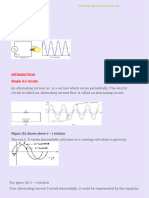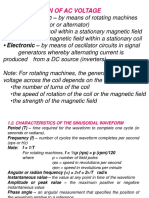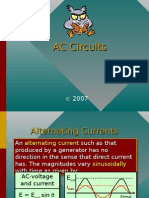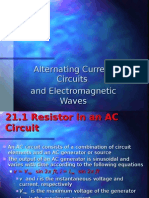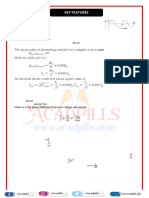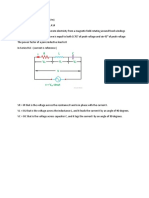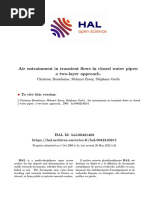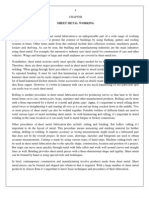Alternating Current-1
Alternating Current-1
Uploaded by
bholu803201Copyright:
Available Formats
Alternating Current-1
Alternating Current-1
Uploaded by
bholu803201Original Title
Copyright
Available Formats
Share this document
Did you find this document useful?
Is this content inappropriate?
Copyright:
Available Formats
Alternating Current-1
Alternating Current-1
Uploaded by
bholu803201Copyright:
Available Formats
Alternating current
7. ALTERNATING CURRENT
Alternating current
Current (or Voltage) that varies periodically with time is called an alternating
current (or voltage).
Instantaneous value of alternating current or voltage
The instantaneous value of an alternating voltage is given by
V = V0 sin
Where, V – alternating voltage at time t
V0 - peak value of alternating voltage.
Angular frequency AC
The instantaneous value of an alternating current is given by
I = I0 sin
Where, I – alternating current (ac) at time t
Peak value of an alternating current.
Peak value of AC
The maximum value attained by the current or voltage in either half of the cycle
is called the peak value.
Alternating voltage, V = V0 sin and
Alternating current, I = I0 sin
Where, V0 = NAB , peak value of voltage and
, peak value of current
Angular frequency
– frequency of alternating voltage
Mean value of average value of AC.
The average (mean) value of AC is the mean of the instantaneous values of AC
taken over half a cycle.
Note:
1. The relation between mean value and peak value of alternating current
Average (mean) value of voltage, and
Average (mean) value of current,
2. The average value of AC over one complete cycle is Zero. It is because positive
half cycle is exactly equal to the negative half cycle.
rms value or effective value of alternating current
The rms value of AC is defined as the root of the square of the instantaneous
values over a complete cycle.
Note:
1. The relation between rms value and peak value of alternating current
The rms value of voltage, Vrms = 0.707V0
√
The rms value of current, Irms =
√
2. Alternating voltage and current are represented by rotating vectors called
phasors.
3. A diagram which represents the phase relationship between alternating voltage
and alternating current is called a phasor diagram.
Sri Narayana pu college, Malur Page 1
Alternating current
AC Voltage applied to a resistor:
Derivation of an expression for instantaneous current in an ac circuit
containing a pure resistor with a phasor diagram.
Consider a pure resistor of resistance R connected to an AC source.
The applied instantaneous voltage is given by
V = V0 sin - - - - - (1)
The resulting instantaneous current is
From equation (1)
- - - - - (2)
Where, , peak value of current
From equations (1) and (2), it is clear that the voltage and current are in phase
with each other.
Note: The phase difference between the alternating voltage and current in a
circuit containing pure resistance is 0.
AC voltage applied to an inductor:
Derivation of an expression for instantaneous current in an AC current
containing a pure inductor.
Consider a pure inductor of inductance L connected to an AC source.
The applied instantaneous voltage is given by
V = V0 - - - - - - - - (1)
The induced emf in the coil is
( ) - - - - - - - - (2)
Where, ( ) is the rate of change of current
From Kirchhoff’s voltage low,
- - - - - -- - (3)
Equation (1) and (2) in (3) we get,
( )
( ) - - - - - - - - -(4)
Integrate on both sides
∫ ( )∫
( )( )
I ( )* ( )+ | ( )
( )
Where, ( ) peak value of current
From equations (1) and (5) it is clear that the current lags behind the applied
voltage by or 90°.
Note:
The phase relationship between that the current and voltage in an ac circuit
containing pure inductor is radian or 90°.
Sri Narayana pu college, Malur Page 2
Alternating current
Inductive reactance
Inductive reactive is the opposition offered by an inductor to the flow of AC.
We have,
Inductive reactance is the ratio of rms value of voltage across the inductor to rms
value current through the inductor.
Note:
1. The S I unit of inductive reactance is ohm (Ω).
2. The inductive reactance is given by
3. The inductive reactance increases with
(i) Increase in the frequency of AC and
(ii) Increase in the inductance of the coil.
4. Inductor does not offer reactance to a steady or direct current.
[For steady or direct current, = 0 ( )
The graphical variation of inductive reactance with frequency of the applied
alternating voltage.
AC voltage applied to a capacitor:
Derivation of the expression for the current when an AC voltage is applied
across a pure capacitor.
Consider a pure capacitor of capacitance C connected to an AC source.
The applied instantaneous voltage is given by
V = V0 - - - - - - (1)
The charge on the capacitor at time t is
q = CV
From equation (1)
q = CV0 - - - - - - - (2)
The instantaneous current in the circuit is
- - - - - - - - (3)
Equation (2) in (3) we get,
( )
( )
I ( )
I ( ) | ( )
( )
( )
Where, , peak value of current.
( )
From equations (1) and (4) it is clear that the current leads the applied
voltage by .
Note:
The phase relationship between the current and voltage in an ac circuit
containing a pure capacitor is radian or 90°.
Sri Narayana pu college, Malur Page 3
Alternating current
Capacitive reactance
Capacitive reactance is the opposition offered by a capacitor to the flow of AC.
We have,
( )
Capacitive reactance
Capacitive reactance is the ratio of the rms value of voltage across the capacitor
to the rms value of current through the capacitor.
Note:
1. The S I unit of capacitive reactance is ohm (Ω).
2. The capacitive reactance is given by
3. The capacitive reactive increases with
(i) The decrease in frequency of AC and
(ii) The decrease in the capacitance of the capacitor.
4. The resistance offered by a capacitor to dc is Infinity.
5. At very high frequency of AC, a capacitor behaves as a pure conductor
Because, as frequency is increased, XC decreases( ). Therefore, for
very high frequency, XC will be nearly zero and capacitor behaves as a
conductor.
The graphical variation of capacitive reactance with frequency of the
applied alternating voltage.
Distinguish between inductive reactance and capacitive reactance.
Inductive Reactance Capacitive Reactance
1. It is the opposition offered 1. It is the opposition offered by
by an inductor to the flow of a capacitor to the flow of AC.
AC
2. 2.
3. XL 3.
4. , for dc 4. for dc
AC voltage applied to series LCR circuit:
Derivation of an expression for impedance and current in a series LCR
circuit by phasor diagram method.
Consider a pure inductor of inductance L, pure capacitor of capacitance C and a
pure resistor of resistance R are connected in series with an AC source voltage V.
let, XL – inductive reactance and XC – capacitive reactance.
Let I be the current in a circuit at any instant of time.
Sri Narayana pu college, Malur Page 4
Alternating current
Potential difference across L is
VL = IXL -------- (1)
Potential difference across C is
VC = IXC -------- (2)
Potential difference across R is
VR = IR -------- (3)
Since VL > VC, then (VL – VC) is represented by OD.
Then the resultant voltage V across the combination is represented by OE.
From
( )
From equations (1), (2) and (3)
( ) ( )
( )
( )
√ ( )
The impedance in the circuit is √ ( ) ,
Current in the circuit
The phase difference between current and voltage in an LCR circuit
In the figure, from le OAB
But, VL = IXL , VC = IXC and VR = IR
( )
Note:
1. The instantaneous current through a series LCR circuit is given by
( ) If
( ) If
2. If the circuit is inductive
3. If the circuit is capacitive
4. If , the circuit is resistive.
Impedance of an AC circuit
Impedance of an LCR series circuit is the effective opposition for the flow of AC
due to L, C and R together.
Note:
1. The SI unit of impedance is ohm (Ω)
2. Impedance of a series LCR circuit depends on
(i) Resistance of the circuit
(ii) Capacitance of the capacitor
(iii) Inductance of the inductor
(iv) Frequency of AC.
3. The expression for the phase difference between current and voltage in an
LCR circuit in terms of resistance and impedance.
Phase difference between V and I is
( )
Sri Narayana pu college, Malur Page 5
Alternating current
Electrical Resonance in a series LCR circuit
The phenomenon in which for a particular frequency of the applied voltage the
impedance of the series LCR circuit is minimum and current is maximum is
called the resonance.
Derivation of an expression for the resonant frequency
At resonance, Inductive reactance = capacitive reactance.
√
This is the resonant frequency of a series LCR circuit.
Resonant frequency
Resonant frequency (f0) is the frequency of the applied AC at which the current
through the circuit is maximum.
Note:
The salient feature of series LCR circuit at resonance
1. Inductive reactance is equal to the capacitive reactance, i,e., .
2. Current in the circuit is maximum.
3. Circuit is purely resistive
4. Impedance is equal to the resistance in the circuit i.e., Z = R
5. Phase difference between the current and voltage is zero.
6. Power factor is unity, i.e., cos
7. Series resonant circuit is used in the tuning mechanism of a radio or a
television set.
8. The resonant frequency depends on
1. Inductance of an inductor 2. Capacitance of capacitor.
9. The resonant frequency of series LCR circuit is independent of resistance.
Expressions for Bandwidth and Quality Factor
Note: Sharpness of resonance:
A graph plotting between current and frequency of the applied AC voltage is
called resonance curve.
In LCR series circuit as the applied frequency is increased, the current increases
and becomes maximum at V = V0 and then decreases again.
The maximum current at V0 is given by
Since Zmin = R. Thus, smaller the value of R larger will be the Q-factor of the
circuit. i.e,. the sharpness of resonance is higher and the circuit is more
selective.
The sharpness of resonance is measured by quality factor.
Sri Narayana pu college, Malur Page 6
Alternating current
Q-factor: The Q-factor of a series resonant circuit is defined as the ratio of the
voltage developed across the inductor or capacitor at resonance to the applied
voltage.
Or Q-factor can also be defined as the ratio of resonant frequency to the
bandwidth at rms current.
The expression for Q-factor in terms of band width is
Note:
1) The Q-factor of a series resonance circuit can be improved.
1. by decreasing resistance of the circuit.
2. by decreasing capacitance of the capacitor.
3. by increasing the inductance of an inductor.
2) The significance of Q-factor is a measure of sharpness of resonance
Bandwidth
The difference in the frequencies corresponding to the rms current in a
resonance curve is called a bandwidth.
The expression for bandwidth is
Where, upper cut-off frequency
Lower cut-off frequency at Irms
Power in AC circuit
The rate at which electrical energy is consumed in AC circuit is called power in
AC circuit.
Average (true) power in an AC is given by
Where, ( ) is called apparent power and cos is called power factor.
Note:
The power dissipation
1) For purely resistive circuit, or cos
(Power dissipation is maximum)
2) For purely inductive circuit, or cos
3) For purely capacitive circuit, or cos
4) At resonance, LCR series circuit is purely resistive
Z = R and or cos
i.e., power dissipation is maximum.
Power factor of an AC circuit
Power factor is defined as the ratio of true power to apparent power.
OR
Power factor is the cosine of the angel between the voltage and the current in AC
circuit.
Power factor = cos
Note:
1) Power factor of a series LCR circuit depends on
(i) Inductance of an inductor.
(ii) Resistance of the resistor and
(iii) Frequency of ac source
2) The relation between power factor, impedance and resistance on an AC circuit
cos
Where, R – resistance and Z – impedance.
Sri Narayana pu college, Malur Page 7
Alternating current
3) The value of power factor of a series LCR circuit at resonance
Power factor, cos and is maximum (Because Z = R)
4) For a pure resistive circuit,
Power factor, cos and is maximum
5) For a pure inductive or a capacitive circuit,
Power factor, cos and is minimum.
Wattles Current
The current in the circuit for which the power dissipation is zero is called wattles
current.
Example: Current through a pure inductor or a pure capacitor.
Note:
A circuit consisting of a choke dissipates no power, therefore the chock is called
a wattles component.
LC Oscillations
When a charged capacitor is allowed to discharge through an ideal inductor,
electrical oscillations of constant amplitude and frequency are produced. These
oscillations are called LC oscillations or undamped oscillations.
NOTE
Qualitative discussion of the LC oscillations production
Consider a capacitor of capacitance C. Let it be charged q0
and connected to an ideal inductor of inductance L, the
capacitor begins to discharge (figure). As it does so, an emf is
induced in the inductor.
During the first quarter cycle, the charge is reduced to zero
and the energy stored in the capacitor is completely
transferred to the magnetic field around the inductor. At this
instant magnetic energy, UB .
During the second quarter cycle, the capacitor is recharged with polarity opposite
to that of initial charge and the magnetic energy is completely transferred from
inductor to the electric field in the capacitor, UE
During the third quarter cycle, the charge on the capacitor is reduced to zero
and the electrical energy stored in the capacitor is completely transferred to the
magnetic field around the inductor.
During the fourth quarter cycle, the capacitor is recharged to its original state
and energy is transferred back to the electric field of the capacitor.
The energy in the LC oscillations between the capacitor and the inductor varies
but the total energy remains constant. These oscillations are similar to the
mechanical oscillation of a block of mass attached to a spring.
Note:
The undamped LC oscillations are not realistic because of two reasons.
1. Every inductor has some resistance. As current flows through this resistance,
energy is spent. Therefore, energy of the system goes on decreasing and finally
the oscillations stop. Such oscillations damped oscillations.
2. Even if the resistance of the inductor is zero, the system loses energy in the
form of electromagnetic spectrum. Radio and TV transmitters depend on this
radiation.
Sri Narayana pu college, Malur Page 8
Alternating current
Expression for the resonant frequency of LC oscillations
The expression for the resonant frequency of LC oscillations is given by
√
Where, L – Inductance of an inductor,
C – Capacitance of the capacitor.
Note:
1. Maximum energy stored in a capacitor,
2. Maximum energy stored in an inductor,
3. Total energy stored in LC circuit,
4. In LC undamped oscillations,
Transformer
A transformer is a device used to vary AC voltage and current.
Principle: It works based on the principle of mutual induction.
Construction: A transformer consists of primary coil P and secondary coil S of
insulated wire wound separately over a laminated soft iron core. The input AC
voltage to be altered is connected to the primary coil and the altered output AC
voltage is obtained across the secondary coil.
Working: When an input AC is applied to the primary coil, it creates a varying
magnetic field and hence a changing magnetic flux in the core. Due to the
mutual induction, the changing flux causes induced emf in secondary coil. Thus,
the power is transferred from primary to secondary.
The function of a step up transformer
Step up transformer converts low alternating voltage into high alternating voltage
or high alternating current into low alternating current.
Note:
Expression for Turns Ratio or the theory of transformer
Let be the magnetic flux in each turn in the core at time t due to the current in
the primary coil of the transformer.
Let Np and Ns be the number of turns in the primary and secondary of the
transformer respectively. Then induced emf in the primary coil.
- - - - - - - - - (1)
Induced emf in the secondary coil,
- - - - - - - - - - (2)
If Vp is the applied voltage across primary and Vs is the output voltage across
secondary,
We have, and (to good approximation)
From equations (1) and(2) we get,
Where, T is the transformation ratio or turns ratio of the transformer.
Sri Narayana pu college, Malur Page 9
Alternating current
Note:
Transformer cannot be used to step up a dc voltage
The transformer is said to be an ideal if the output power is equal to the input
power.
1. If turns ratio, T > 1 i.e., NS > NP. then VS > VP , it is called step up transformer.
2. If turns ratio, T < 1 i.e., NS < NP. then VS > VP, it is called down transformer.
3. The dc supply does not produce a changing magnetic field in the primary.
Hence no emf is induced in the secondary of the transformer. Thus, a
transformer cannot be used in dc.
4. The ratio of input power to the input power in the transformer is called its
efficiency. i.e.,
5. For an ideal transformer,
6. In practical transformer, due to the power losses
Sources of energy losses in a transformer
The sources of power loss in a transformer
1. Loss due to flux leakage
2. Loss due to resistance of the windings.
3. Loss due to eddy currents.
4. Loss due to magnetic hysteresis
Note:
1. Copper lasses in a transformer
The primary and secondary winding of a transformer have resistance. The I 2 R
losses that occur due to current flow in these winding are called copper losses.
2. Iron losses in a transformer
The losses occur in the core (hysteresis loss) of a transformer are called core
losses or iron losses.
3. Iron loss can be reduced by using laminated core in the transformer.
4. Transformer cores are laminated to minimize energy loss(hysteresis loss) due
to eddy current.
5. The core of transformer is made of soft magnetic materials (like soft iron)
because they have low hysteresis.
The two characteristic properties of a material suitable for making core of a
transformer
1. Low retentivity.
2. Low coercivity.
3. Low hysteresis loss
4. High permeability
Uses of transformers
Transformers are used
1. in the long-distance transmission of electric power
2. in voltage regulators for TV, Refrigerators etc.
3. In stabilized power supplies
4. for the production of X-rays, etc.
Sri Narayana pu college, Malur Page 10
Alternating current
IMPORTANT QUESTIONS
1 MARKS
1. Define the following terms.
a) Mean value of AC. b) Root mean square value of AC. c) Peak value of AC.
2. What is the phase difference between current and voltage in
a) Pure Inductor b) Pure capacitor c) Pure Resistor.
3. What is inductive Reactance?
4. What is capacitive Reactance?
5. What is the value of frequency of AC and DC in India?
6. What is impedance?
7. What is Resonance?
8. Define power factor?
9. What is wattles current?
10. What is principle used in transformer?
11. Draw the graphs for the variation of Xc with frequency.
12.Draw the graphs for the variation of XL with frequency.
13. Give the relation between mean value and rms value of a sinusoidal AC.
14. Give the relation between peak value and rms value of alternating current.
15. Mention the condition for resonance in series LCR circuit.
2 MARKS
16. Define quality factor and mention the expression for it in a series LCR
circuit?
17. Write any two uses of transformer.
18. Define band width and mention the expression for it.
19. What are LC oscillations and mention the expression for frequency of LC
oscillations.
3 MARKS
1. Derive an expression for instantaneous current when an AC is applied to
pure resistor.
2. Obtain an expression for the resonant frequency in series LCR circuit.
3. Distinguish between step up and step-down transformer.
4. Mention any three sources of energy loss in transformer.
5. What is the power factor in
a) Resistive circuit b) capacitive circuit c) inductive circuit.
5 MARKS
1. Derive an expression for instantaneous current when an AC is applied to
pure inductor.
2. Derive an expression for instantaneous current when an AC is applied to
pure capacitor.
3. Derive an expression for impedance and current through LCR circuit
by phasor diagram method.
4. What is a transformer? What is the principle of a transformer?
Describe its construction and working with neat diagram.
Sri Narayana pu college, Malur Page 11
You might also like
- CE5107 - Lateral Pile Load TestDocument19 pagesCE5107 - Lateral Pile Load TestMartin ČudejkoNo ratings yet
- Alternating CurrentDocument18 pagesAlternating CurrentGladwin SolomonNo ratings yet
- AlternatingCurrentCircuit ClassNotes - NG 1709124407198Document14 pagesAlternatingCurrentCircuit ClassNotes - NG 1709124407198dasiakennethNo ratings yet
- LessonNoteonPhysicsSS3SecondTerm Edudelight.com 1735982838066Document59 pagesLessonNoteonPhysicsSS3SecondTerm Edudelight.com 1735982838066okunola oluwayimikaNo ratings yet
- Chapter 16 NotesDocument15 pagesChapter 16 NotesMian EjazNo ratings yet
- Basic Electrical by FarhanaDocument28 pagesBasic Electrical by FarhanaEr Rouf UlAlam BhatNo ratings yet
- Phasor Concept: M V M VDocument11 pagesPhasor Concept: M V M VKim Andre MacaraegNo ratings yet
- 14 Alternating CurrentDocument39 pages14 Alternating CurrentWebby ZimbaNo ratings yet
- BEE Lecture 14-15Document31 pagesBEE Lecture 14-15Jasmine HansdaNo ratings yet
- question lab 7Document3 pagesquestion lab 7ngominhkhoa2005No ratings yet
- UNIT-II AC Circuits (1)Document78 pagesUNIT-II AC Circuits (1)Lakshay AryaNo ratings yet
- Lec 1 PDFDocument19 pagesLec 1 PDFJoshua Roberto GrutaNo ratings yet
- Single Phase ACDocument133 pagesSingle Phase ACShashidhar Kasthala100% (2)
- Electric Circuit AnalysisDocument116 pagesElectric Circuit Analysismbuja mbujaNo ratings yet
- NGFO70 BE1 Eh 6 Ibp Rwiv 7Document9 pagesNGFO70 BE1 Eh 6 Ibp Rwiv 7Aaditya manojNo ratings yet
- Physics AC PDFDocument12 pagesPhysics AC PDFAisha ZubairNo ratings yet
- AC Fundamentals Introduction TheoryDocument25 pagesAC Fundamentals Introduction TheoryAlex ZulNo ratings yet
- PC Chapter 33Document70 pagesPC Chapter 33ultimuNo ratings yet
- Tridib's Physics Tutorials: VisitDocument19 pagesTridib's Physics Tutorials: VisitvinaykumarcNo ratings yet
- 1208 EEC MIcroprojectDocument16 pages1208 EEC MIcroprojectDibyas Sanjay DubeyNo ratings yet
- Alternating Current: V I Sin T RDocument8 pagesAlternating Current: V I Sin T RVeeresh SavadiNo ratings yet
- 3elec CircuitDocument37 pages3elec Circuiteuge sylNo ratings yet
- EXP5Document4 pagesEXP5A foinniNo ratings yet
- Alternating CurrentDocument39 pagesAlternating CurrentRichard GomezNo ratings yet
- Ac and EmwavesDocument2 pagesAc and EmwavesKush AgarwalNo ratings yet
- AC Notes1Document12 pagesAC Notes1Varun Chaudhary100% (1)
- A.C. Circiuits NotesDocument38 pagesA.C. Circiuits NotesbenjadiditNo ratings yet
- AC CircuitsDocument38 pagesAC CircuitsAashish SapkotaNo ratings yet
- Single Phase AC CircuitsDocument27 pagesSingle Phase AC Circuitskali hembramNo ratings yet
- 1ST NOTE SS3Document17 pages1ST NOTE SS3itodostella2009No ratings yet
- Module 2 Ele PDFDocument38 pagesModule 2 Ele PDFRif RizNo ratings yet
- Chapter 33Document70 pagesChapter 33varpaliaNo ratings yet
- Alternating Current Circuits and Electromagnetic WavesDocument31 pagesAlternating Current Circuits and Electromagnetic WavesMainuddinJewelNo ratings yet
- Alternating-Current CircuitsDocument14 pagesAlternating-Current Circuitstalal.saadaaNo ratings yet
- Physics II Problems PDFDocument1 pagePhysics II Problems PDFBOSS BOSSNo ratings yet
- Basic Electrical and Electronics - Question Bank With AnswerDocument93 pagesBasic Electrical and Electronics - Question Bank With Answerharish.m.2024.aimlNo ratings yet
- chapter 7Document11 pageschapter 7ashokkumar9105630191No ratings yet
- Chapter 7 - Alternating CurrentDocument7 pagesChapter 7 - Alternating Currentjanviagarwal1556No ratings yet
- Communication MaterialDocument9 pagesCommunication MaterialJHEMANTHNo ratings yet
- 1.1 Describe Generation of A Single Phase Sinusoidal Alternating CurrentDocument13 pages1.1 Describe Generation of A Single Phase Sinusoidal Alternating CurrentMathew Pak Yu CheungNo ratings yet
- AC circuitsDocument10 pagesAC circuitsswarup.r0597No ratings yet
- 7. Alternating CurrentDocument30 pages7. Alternating Currentsriyunesh26No ratings yet
- Chapter 32 ADocument42 pagesChapter 32 AmaheshNo ratings yet
- Bab 2 Inductors Capacitors and Alternating Current CircuitsDocument42 pagesBab 2 Inductors Capacitors and Alternating Current CircuitsVimal SaravananNo ratings yet
- Alternating Current A.C.Document19 pagesAlternating Current A.C.Puran BistaNo ratings yet
- Question Bank With Answers: BE 8253 - Basic Electrical, Electronics and Instrumentation EngineeringDocument93 pagesQuestion Bank With Answers: BE 8253 - Basic Electrical, Electronics and Instrumentation EngineeringRajeshNo ratings yet
- The Basic Elements & PhasorsDocument120 pagesThe Basic Elements & PhasorsShah ZamanNo ratings yet
- Ac Imp QuestionsDocument2 pagesAc Imp Questionsrishikeshm1221No ratings yet
- TheoryDocument20 pagesTheoryJatin hemwaniNo ratings yet
- Unit 1 - Electric and Magnetic CircuitDocument71 pagesUnit 1 - Electric and Magnetic CircuitYash ChavanNo ratings yet
- Alternating Current: Peak Value and R.M.S ValueDocument9 pagesAlternating Current: Peak Value and R.M.S ValueBinod KhatriNo ratings yet
- Lecture 1_Part1Document14 pagesLecture 1_Part1SILENT KILLER GAMINGNo ratings yet
- Mod2 AC Circuits Provided by MaamDocument72 pagesMod2 AC Circuits Provided by Maamanishdeshmukh369No ratings yet
- Alternating CurrentDocument16 pagesAlternating Currentgowopah131No ratings yet
- AC CircuitDocument34 pagesAC Circuitno.1slytherinprincessNo ratings yet
- Note 1 - Fundamental of Electric CircuitsDocument93 pagesNote 1 - Fundamental of Electric Circuitssyedfadlan91100% (1)
- NUCLEI 2 (1) - Page-0001Document10 pagesNUCLEI 2 (1) - Page-0001bholu803201No ratings yet
- ContinuityDocument3 pagesContinuitybholu803201No ratings yet
- DifferentiationDocument8 pagesDifferentiationbholu803201No ratings yet
- English AssinmentDocument18 pagesEnglish Assinmentbholu803201No ratings yet
- Electrochemistry Notes...Document11 pagesElectrochemistry Notes...bholu803201No ratings yet
- Jee Main 2024 Maths SyllabusDocument8 pagesJee Main 2024 Maths Syllabusbholu803201No ratings yet
- Finned Tube R134a CondenserDocument12 pagesFinned Tube R134a CondensermattiturboNo ratings yet
- Air Entrainment - 02Document16 pagesAir Entrainment - 02ThejaswiniNo ratings yet
- Solar Powered Reciprocating Pump - SynopsisDocument15 pagesSolar Powered Reciprocating Pump - SynopsisShailesh RanawareNo ratings yet
- Helical Pile Behaviour and Load Transfer Mechanism in Different SoilsDocument8 pagesHelical Pile Behaviour and Load Transfer Mechanism in Different SoilsBangun KaryaMartaNo ratings yet
- Modelos de Slip FactorDocument7 pagesModelos de Slip FactorJulio Alejandro GómezNo ratings yet
- The Machinability of Nickel-Based Alloys: A Review: E.O. Ezugwu, Z.M. Wang, A.R. MachadoDocument16 pagesThe Machinability of Nickel-Based Alloys: A Review: E.O. Ezugwu, Z.M. Wang, A.R. MachadosenthilNo ratings yet
- CoreBrace Bolted BRB Connection TableDocument2 pagesCoreBrace Bolted BRB Connection TableAndrew WeiNo ratings yet
- Recubrimiento Metalico en Turbinas FrancisDocument2 pagesRecubrimiento Metalico en Turbinas FrancisearizabalNo ratings yet
- Castech PP-8000.E: Technical Data SheetDocument2 pagesCastech PP-8000.E: Technical Data SheetDileepa DissanayakeNo ratings yet
- Quicktrap Series: Lower Replacement CostsDocument2 pagesQuicktrap Series: Lower Replacement Costsalejandro obregonNo ratings yet
- Additive SummaryDocument7 pagesAdditive SummaryIdrissHemsasNo ratings yet
- ASTM E-1530 - Conductividad TermicaDocument9 pagesASTM E-1530 - Conductividad TermicaArmando González MercadoNo ratings yet
- Acid Base Equilibria and Salt EquilibriaDocument11 pagesAcid Base Equilibria and Salt EquilibriaAMEER HANAFI JIKIRI. JUL-ASRINo ratings yet
- Metallurgical Failure AnalysisDocument2 pagesMetallurgical Failure AnalysisShuaib KunnekkattuNo ratings yet
- Wear of Aluminium Bronze On Steel Under Conditions of Boundary LubricationDocument7 pagesWear of Aluminium Bronze On Steel Under Conditions of Boundary LubricationFathia AlkelaeNo ratings yet
- Sample Ribbed Slab Design by TCC SpreadsheetsDocument3 pagesSample Ribbed Slab Design by TCC Spreadsheetsyusuf abdinasirNo ratings yet
- WTTC9 Proceedings 2002 Comor COSTIS Solid Target p59Document186 pagesWTTC9 Proceedings 2002 Comor COSTIS Solid Target p59Juan CarlosNo ratings yet
- Foot Trajectory For A Quadruped Walking MachineDocument8 pagesFoot Trajectory For A Quadruped Walking MachineMer FroNo ratings yet
- Dew Point & Relative Humidity Lab-1Document6 pagesDew Point & Relative Humidity Lab-1fruity pebblesNo ratings yet
- hssc1700t Secstudygd PDFDocument5 pageshssc1700t Secstudygd PDFmarwanmahmoud123442No ratings yet
- Solutions For Mechanics of Materials AssignmentDocument14 pagesSolutions For Mechanics of Materials AssignmentSparkNo ratings yet
- TextbookDocument87 pagesTextbookamitabha0107No ratings yet
- Strength of MaterialsDocument1 pageStrength of MaterialsLebron JamesNo ratings yet
- Module-I Unit-I Oscillations and WavesDocument2 pagesModule-I Unit-I Oscillations and WavesFayaz Ahmed KhanNo ratings yet
- Sheetmetal IntroductionDocument9 pagesSheetmetal IntroductionVinay BalineniNo ratings yet
- FGGD DDocument2 pagesFGGD DScarlordNo ratings yet
- Analysis of PVA/CNF Organic Polymers Blend Membranes: Anshika Patel, Varij PanwarDocument8 pagesAnalysis of PVA/CNF Organic Polymers Blend Membranes: Anshika Patel, Varij PanwarAnshika PatelNo ratings yet
- CO2 Mollier Chart PDFDocument1 pageCO2 Mollier Chart PDFmarko quirozNo ratings yet
- Chapter-1 Intro & Properties of Particulate SolidsDocument11 pagesChapter-1 Intro & Properties of Particulate SolidsKartik DesaiNo ratings yet


